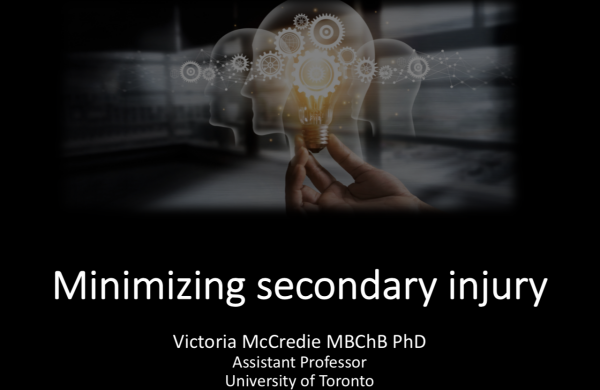
Minimizing secondary brain injury at the bedside #ISICEM19
Secondary brain injury is a frequent event
Minimizing secondary brain injury at the bedside #ISICEM19
Victoria McCredie, University of Toronto
Presentation slides
Take Home messages:
Importance of neuroprotection
- The overall aim of our intensive care management has also been to protect the brain, to ensure perfusion to the brain and meet its metabolic demands.
- We should always be thinking about how to ANTICIPATE, PREVENT, or HALT secondary brain insults regardless of whether we are looking after a specific neurocritical patient, or a septic patient!
Importance of differential pathophysiological mechanisms
STRUCTURE
- The concept of different pathophysiological mechanisms cannot be overstressed.
- Following the primary cerebral insult, a cascade of events amplifies the initial damage regardless of the etiology of the precipitating event.
- Cerebral hemorrhage, edema, and axonal injury can present similarly, but have drastically different clinical trajectories.
- If we look at structural changes, here at a macroscopic level we might see damage includes shearing of white-matter tracts, focal contusions, hematomas (intracerebral and extracerebral) or diffuse swelling.
- Each type of head injury might initiate VERY different pathophysiological mechanisms, with variable extent and duration.
- These mechanisms (acting concurrently and often with synergising effects) and the intensity of systemic insults determine the extent of secondary brain damage.
- The contributions of each of these pathways to the secondary brain injury vary depending on the specific TBI lesion; for example, inflammation-mediated brain injury seems predominant in contusion while calcium-mediated injury predominates in diffuse axonal injury
TIME
- Dynamic and PROGRESSIVE process following injury
- Secondary brain injury processes develop over hours and days, and include neurotransmitter release, free-radical generation, calcium-mediated damage, gene activation, mitochondrial dysfunction, and inflammatory responses.
Neuroprotective agents
- Neuroprotective strategies that limit secondary tissue loss and improve functional outcomes have always been an important goal
- Over the past 20 years, research has focused on the possibility of early pharmacological agents to improve outcomes in brain injured patients
- Over 30 clinical trials have failed to translate a therapeutic agent for clinical use and numerous explanations for this failure have been postulated
- Has this deflected attention from the development of neuroprotective strategies and trials addressing everyday ICU management such as optimal hemodynamic management
Outcomes improving over time
- Despite repeated failures in pharmacological neuroprotection, outcomes for TBI patients have improved.
- Likely that the organization of intensive treatment has contributed, offering a different kind of neuroprotection based on careful prevention and limitation of intracranial and systemic threats.
Secondary brain injury targets
- Neurophysiologic targets: Hypoxemia/hyperoxemia, hypotension, intracranial hypertension, hypoglycemia, fever
- Neurophysiologic concepts:
- Secondary insult ‘dose
- ICP dose
- Pressure*time burden of intracranial hypertension
- We always talk about a THRESHOLD, but the burden of time really appears to affect longer term outcome
- Individualized thresholds
- Towards individualized thresholds in Neurocritical Care with neuromonitoring
- Cerebral perfusion pressure thresholds- may depend upon the patient’s autoregulatory status
- Ability to tolerate burden of intracranial hypertension dependent on CA
- Trajectory
- Think about dynamic assessments of patients at the bedside, incorporating trajectory over minutes to hours
Neuroprotection at the bedside
- Detection of secondary insults at the bedside
- Integrated neurophysiologic monitoring
- Up to 40% of TBI patients show a clinically relevant neurological worsening within the first 48 hours
- How do we detect secondary brain insults in a comatose patient?
- The role of an integrated neuromonitoring approach
- With mounting evidence that a single neuro-monitor cannot comprehensively detect all instances of cerebral compromise, multimodal neuromonitoring allows an individualized approach to patient management based on monitored physiologic variables rather than a generic one-size-fits-all approach targeting predetermined and often empirical thresholds.
- We are seeing a change from pure neurological clinical evaluation to an era of structural definition, associated with monitoring of cerebral hemodynamics, oxygenation, metabolism, and electrophysiology.
- It remains to be demonstrated whether multimodal monitoring-guided therapy is able to improve outcome.
- Translation of neuroprotective strategies at the bedside
- Standardized management protocol
- How can protocols improve patient care?
- Facilitate communication
- Reduce cognitive load
- Coordinate the interdisciplinary team
- Increase the adoption of evidence-based interventions and improve adherence to guidelines
Summary:
- Secondary brain injury is a frequent event in TBI patients.
- These events greatly influence prognosis and are potentially preventable.
- Our understanding of secondary brain injury mechanisms and physiologic responses to treatment is evolving.
Suggested reading:
- Maas AI, Stocchetti N, Bullock R. Lancet Neurol. 2008 Aug;7(8):728-41. doi: 10.1016/S1474-4422(08)70164-9. Moderate and severe traumatic brain injury in adults.
- Stocchetti N, Le Roux P, Vespa P, Oddo M, Citerio G, Andrews PJ, Stevens RD, Sharshar T, Taccone FS, Vincent JL. Crit Care. 2013 Jan 15;17(1):201. doi: 10.1186/cc11513. Clinical review: neuromonitoring - an update.
- Rosenfeld JV, Maas AI, Bragge P, Morganti-Kossmann MC, Manley GT, Gruen RL. Lancet. 2012 Sep 22;380(9847):1088-98. doi: 10.1016/S0140-6736(12)60864-2. Early management of severe traumatic brain injury.
- Güiza F, Depreitere B, Piper I, Citerio G, Chambers I, Jones PA, Lo TY, Enblad P, Nillson P, Feyen B, Jorens P, Maas A, Schuhmann MU, Donald R, Moss L, Van den Berghe G, Meyfroidt G. Intensive Care Med. 2015 Jun;41(6):1067-76. doi: 10.1007/s00134-015-3806-1. Epub 2015 Apr 18. Visualizing the pressure and time burden of intracranial hypertension in adult and paediatric traumatic brain injury.
- McCredie VA, Alali AS, Scales DC, Rubenfeld GD, Cuthbertson BH, Nathens AB. Crit Care Med. 2018 Jul;46(7):1139-1149. doi: 10.1097/CCM.0000000000003149. Impact of ICU Structure and Processes of Care on Outcomes After Severe Traumatic Brain Injury: A Multicenter Cohort Study.